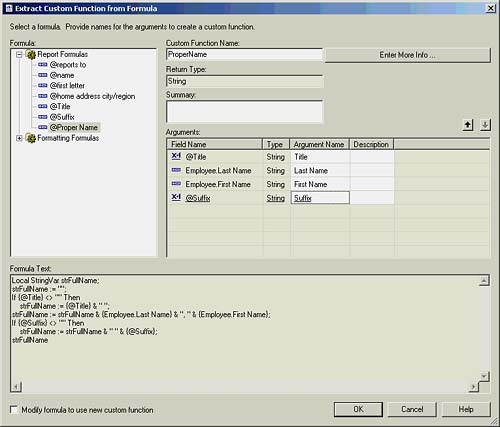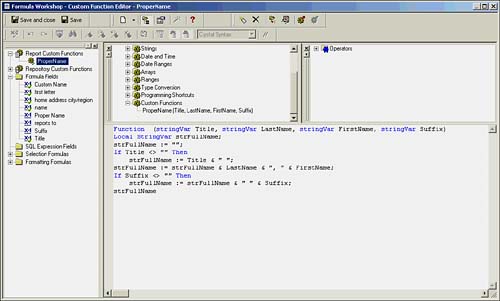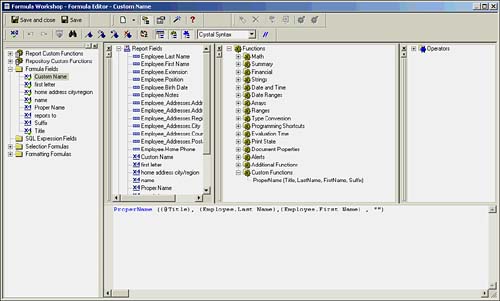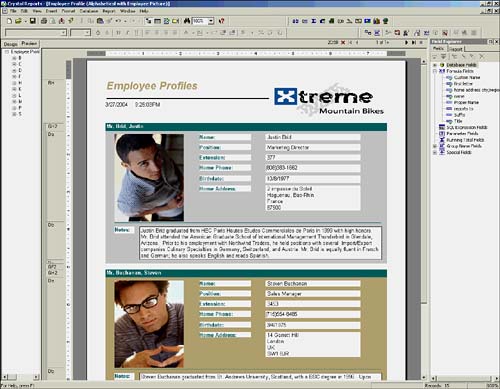Recent Improvements to Formulas
Because Crystal Reports has been around for so many years and has released many versions over those years, it's not uncommon to come across users who are still using older versions. To bring those users up to speed this section covers some of the recent additions and improvements to formulas over the past few versions.
Manipulating Memo Fields in Formulas
In the past, Crystal Reports developers had not been able to access string fields that were longer than 255 characters within the formula language other than to find out whether they were null. This limitation has been completely removed.
For our purposes here, let's assume that the Xtreme Mountain Bike Company management needs an HR report that shows only the female employees, but there is no gender field in the Xtreme database. In the Notes field in the Employee table, the word "she" is used for all female employees. However, Xtreme's management has indicated that they might need to search for other words as well, so they want to have a keyword search instead of hard-coding the search values. Follow these steps to create such a report to fulfill this reporting requirement:
- Open the Employee Profile Report. Press Ctrl+O to open a report. Find the Crystal Reports 9 sample report called Employee Profile. Most installations have it in the following folder: Program FilesCrystal DecisionsCrystal Reports 10SamplesenReportsGeneral Business.
- Create a parameter field by selecting View, Field Explorer. Right-click on the Parameter Field item in the Field Explorer and choose New. In the Create Parameter Field dialog, call the parameter Search-A-Word. Prompting Text should be What word would you like to search for?. The Value Type should be String.
- Click on the Set Default Values button. In the Set Default Values dialog, add "", "she", and "he" to the default values. The final result should look like Figure 13.1.
Figure 13.1. The default values for a Search-A-Word parameter.
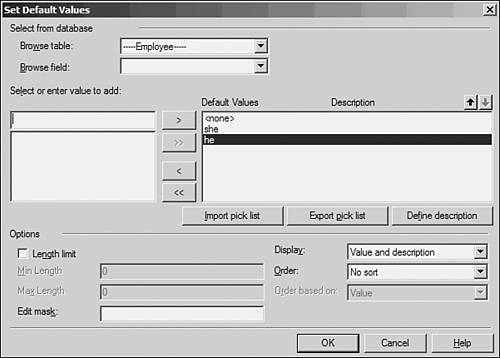
- Click the OK button. The Create Parameter Field dialog should look like Figure 13.2. Click OK.
Figure 13.2. The parameter settings for Search-A-Word.
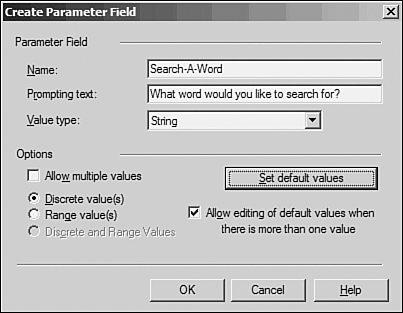
- Connect the parameter to the Selection Formula. Select the Formula Workshop via Report, Formula Workshop. Then choose Selection Formulas, Record Selection from the Workshop tree. Enter the following selection formula into the editor: IF {?Search-A-Word} = "" THEN TRUE ELSE ({?Search-a-Word}) IN LowerCase({Employee.Notes}) and click the Save and Close button.
- Run the report. When prompted, choose she from the Parameter Field prompt and choose to refresh the data. The end result is that only the female employees appear on the report as shown in Figure 13.3. Save the report as Chap13_1.rpt.
Figure 13.3. The Employee Profile showing female employees only.
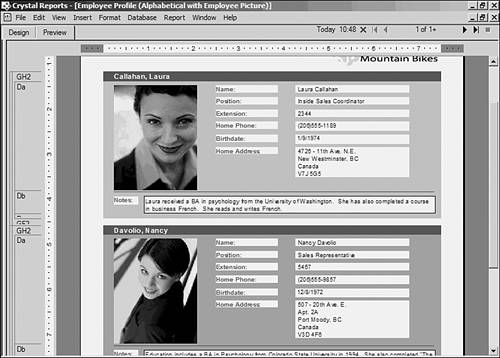
TIP
Notice that you only put the LowerCase() function call around the {Employee.Notes} field and not the parameter. This is because you put the values into the parameter as lowercase by default. However, because you allow the business users to input their own values into the parameter, it might be a good idea to put the LowerCase() function on the parameter as well. This allows Crystal to compare apples to apples when evaluating these exact values. Alternatively, both could have been set to UpperCase() as well.
A keyword search is just one example of how to use a memo field in a formula. The 255-character limit for formulas that was removed in version 9 of Crystal Reports means that practically all database field types can now be accessed in formulas and manipulated. Remember that memo fields are really just long string fields, so they are treated as strings in the formula language. Wherever a string can be called, now a memo field can be called as well.
CAUTION
Not all databases support the capability to search large string fields, so if this type of keyword search is required, more records than necessary might come across the network. For the preceding example, 15 records were returned from the data source but only the 6 that were female were shown on the report. This is because the data source couldn't be passed this selection criteria to handle on the server side.
It is a powerful new feature, but keep in mind that it might bring back more records than you expect.
Working with the Additional Financial Functions
In older versions of Crystal Reports, the financial functions capability of the formula language was limited to 13 functions. However, version 10 of Crystal Reports provides more than 50 financial functions. With overloads for parameters, these functions count up to about 200 variations.
These functions were implemented to give as much functionality as possible to a highly skilled group of report designers. In the past, they had to hand code the financial functions. By including the standard financial functions that most users have seen in Microsoft Excel, these report developers can now develop their formulas much more quickly.
For more information on the Financial Functions available, refer to the Crystal Reports Help file. In the Index, look up "Financial Functions" for a complete list of what is available.
Creating Custom Functions in Your Reports
Custom functions were introduced in Crystal Reports 9 and continue to be a powerful feature of Crystal Reports 10. Although they have been introduced in Chapter 4, "Understanding and Implementing Formulas," this section focuses on some more detailed information on what they are and how they could be used in report development.
Custom functions are packets of business logic that are written in Basic or Crystal syntax. These functions do not have any reference to any database fields at all. Because these functions contain logic that will change values and return a result, the values must be passed in and the results of the logic must be passed out or returned.
Only 10% of a custom function is different from your average formula. As mentioned previously, parameters must be passed in to allow for data manipulation because a custom function is stateless. This means that it has no meaning outside the function it has called in. It acts just like all the other formula functions in the formula language. The only difference is that custom functions can be created, edited, and deleted, whereas Crystal formula functions are completely unchangeable.
Here is a custom function that is provided within the sample repository that comes with Crystal Reports:
Function cdExpandRegionAbbreviation (regionAbbreviation _ As String, Optional country As String = "USA") Select Case UCase (country) Case "CANADA" cdExpandRegionAbbreviation _ = cdExpandRegionAbbreviationCanada (regionAbbreviation) Case "USA", "U.S.A.", "US", "U.S.", "UNITED STATES", _ "UNITED STATES OF AMERICA" cdExpandRegionAbbreviation _ = cdExpandRegionAbbreviationUSA (regionAbbreviation) Case Else cdExpandRegionAbbreviation = regionAbbreviation End Select End Function
Some of the things you will notice about the preceding code are as follows:
- It's in Basic syntax. This is not a requirement of custom functions. They can be in either Basic or Crystal syntax.
- It does not reference database fields directly. Any information that is needed from database must be passed in via the parameters in the first statement (regionAbbreviation).
- It has an optional parameter (Optional country As String = "USA"). This means that this parameter does not necessarily need to be passed in for the function to work. If this parameter is not supplied by the developer in the formula, the value of "USA" is used by default.
- It calls other custom functions. CdExpandRegionAbbreviationCanada and cdExpandRegionAbbreviationUSA are also custom functions. In fact, they are Crystal syntax custom functions. (This shows that Basic and Crystal syntax can call one another.)
- It has a definite end-point (End Function). This allows for the final result (the functions return) to be passed back out to the formula making the call.
TIP
The Enter More Info button takes you to another dialog where you can enter much more descriptive text around the custom function. It also contains fields for categorization and authors. From there, you can also add help text via another dialog. For more information on these dialogs, consult the online help.
Sharing Custom Functions with Others
Two ways in which you can share custom functions are
- By using them in multiple places in one. Because custom functions are stateless, different parameters can be passed in to allow for instant function reuse.
- By sharing them in the Crystal Repository. Custom functions are one of four report object types that can be shared in the repository.
Custom functions can be used in many ways. Take your existing formulas, convert them, and share their logic with others.
Understanding Runtime Errors
Crystal Reports 10 provides the ability to get more information about variables within formulas when a runtime error occurs. In the past, when a runtime error (such as a Divide by Zero) occurred, Crystal would simply take you to the line of the formula giving the error. However, this was not altogether helpful, especially if the error was because the data being passed in from the database could have been at fault. So, in version 9 of Crystal Reports, there is a new feature that shows all variables and data field values used in all related formulas when an error occurs. You can think of this as a variable stack.
The runtime error stack only appears when a runtime error occurs (when real-time data forces an error). It appears where the workshop group tree normally would in the Formula Workshop.
The runtime error stack shows all variables and all database field data related to the formula in question. If custom functions are called within the formula, their variables will appear above the formula as well. The last function to be called will appear at the top.
TIP
The idea of a stack (reverse order) is useful in that the last function called most likely will be where the error is. But, of course, that might not always be the case.
This concept is best shown as an example. Assume that Xtreme Mountain Bike Company's management would like to take the Chap13_1.rpt and find out how much money is not accounted for by days when not shipped (Calculation = Order Amount / Days until shipped). To see how this works, follow these steps to simulate a formula error:
- Use the Chap13_1.rpt again. If it's not already open, open it by choosing Ctrl+O.
- Use the Formula Workshop. Select Report, Formula Workshop. Right-click on the Formula Field branch in the workshop tree and choose New. Name the formula Unaccounted Amount/Day and select Use Editor.
- Add the required logic. In the Editor, enter the following: "{Orders.Order Amount} / {@Days until Shipped}". Click the Save and Close button in the top-left corner. Choose Yes when prompted to save. If the report is not already in Preview mode, press F5 to refresh the report. If you don't see any data, choose Report, Section Expert and make sure that the Details section isn't suppressed. If it is, toggle the option and click OK.
- Drag the field onto the report. From the Field Explorer (View, Field Explorer), select the newly created formula and drag it onto the report to the right of the Days Until Shipped field. Notice that the Divide by Zero error comes up right away. Click OK.
- View the Runtime Error Stack shown in Figure 13.4. In this case, the formula is quite straightforward. The problem is occurring because some of the orders are on time (zero days wait). Xtreme's management would like to show 0 if the orders are on time, so change the formula to the following: "if {@Days until Shipped} = 0 then 0 else {Orders.Order Amount} / {@Days until Shipped}". Click the Save button.
Figure 13.4. Runtime Error Stack next to the newly updated formula.
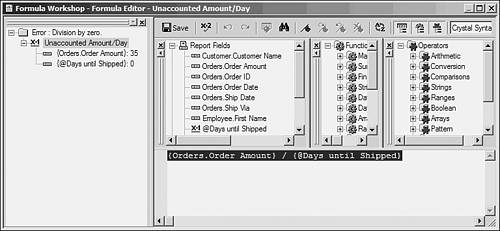
- Click F5 to refresh the report. See the values of the resulting formula as shown in Figure 13.5 and then save the report as Chap13_3.rpt.
Figure 13.5. Resulting Report with the latest Xtreme requirements added.
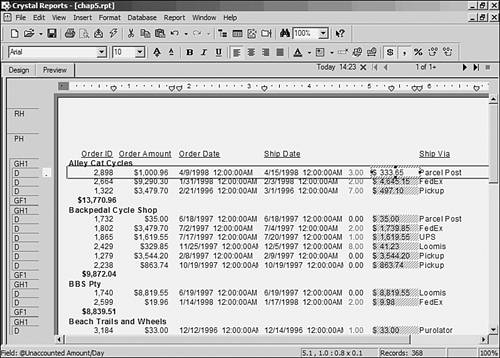
Part I. Crystal Reports Design
Creating and Designing Basic Reports
- Creating and Designing Basic Reports
- Introducing the Crystal Reports Designer
- Understanding Data and Data Sources
- Introduction to the Data Explorer
- Adding Database Objects to Your Report
- Joining Database Objects Together
- Understanding the Different Join Types
- Using the Report Creation Wizards
- Understanding the Crystal Reports Gallery
- Using the Standard Report Creation Wizard
- Creating a Report Without Wizards
- Troubleshooting
Selecting and Grouping Data
- Selecting and Grouping Data
- Introduction
- Understanding Field Objects
- Working with Groups
- Understanding Drill-down Reports
- Troubleshooting
Filtering, Sorting, and Summarizing Data
- Filtering, Sorting, and Summarizing Data
- Introduction
- Filtering the Data in Your Report
- Learning to Sort Records
- Working with the Sort Expert
- Creating Effective Summaries
- Troubleshooting
Understanding and Implementing Formulas
- Understanding and Implementing Formulas
- Introduction
- Using the Formula Workshop
- Using the Workshop Formula Editor
- Creating Formulas with the Formula Expert
- Using the Formula Extractor to Create Custom Functions
- The Multi-Pass Reporting Process of the Crystal Reports Engine
- Troubleshooting
Implementing Parameters for Dynamic Reporting
- Implementing Parameters for Dynamic Reporting
- Introduction
- Understanding the Value of Parameters
- Creating and Implementing Parameters Fields
- Using Parameters with Record Selections
Part II. Formatting Crystal Reports
Fundamentals of Report Formatting
- Fundamentals of Report Formatting
- Introduction
- Positioning and Sizing Report Objects
- Modifying Object Properties for Formatting Purposes
- Exploring the Format Editor Dialog Common Options
- Combining and Layering Report Objects
- Configuring Report Page and Margin Properties
Working with Report Sections
- Working with Report Sections
- Introduction
- Formatting Report Sections
- Modifying Report Section Properties
- Using Multiple Report Sections
- Troubleshooting
Visualizing Your Data with Charts and Maps
- Visualizing Your Data with Charts and Maps
- Introduction to Charts and Maps
- Using the Chart Expert
- Using the Map Expert
- Modifying Chart and Map Properties
- Troubleshooting
Custom Formatting Techniques
- Introduction
- Making Presentation-Quality Reports
- Common Formatting Features
- Conditional Formatting Using Data to Drive the Look of a Report
Part III. Advanced Crystal Reports Design
Using Cross-Tabs for Summarized Reporting
- Using Cross-Tabs for Summarized Reporting
- Introduction to Cross-Tabs
- Benefits of Cross-Tabs
- Using the Cross-Tab Wizard
- Using Top N with Cross-Tabs Reports
- Using Advanced Cross-Tab Features
Using Record Selections and Alerts for Interactive Reporting
- Using Record Selections and Alerts for Interactive Reporting
- Creating Advanced Record Selection Formulas
- Adding Alerting to Your Reports
- Performance Monitoring and Tuning
Using Subreports and Multi-Pass Reporting
- Using Subreports and Multi-Pass Reporting
- Understanding Subreports
- Understanding Linked Versus Unlinked Subreports
- Considering Subreport Execution Time and Performance
- Using Variables to Pass Data Between Reports
- Emulating Nested Subreports
- Troubleshooting
Using Formulas and Custom Functions
- Using Formulas and Custom Functions
- Becoming More Productive with Formulas
- Choosing a Formula Language: Crystal Versus Basic Syntax
- Using Brackets in Formulas
- Using Characters in Formulas
- Recent Improvements to Formulas
Designing Effective Report Templates
- Designing Effective Report Templates
- Understanding the Importance of Reuse in Reporting
- Understanding Report Templates
- Using Report Templates
- Using Existing Crystal Reports as Templates
- Understanding How Templates Work
- Creating Useful Report Templates
- Using Template Field Objects
- Using Report Templates to Reduce Report Creation Effort
- Applying Multiple Templates
Additional Data Sources for Crystal Reports
- Additional Data Sources for Crystal Reports
- Understanding the Additional Crystal Reports Data Sources
- Connecting to COM-based Data Sources
- Connecting to Java-based Data Sources
- Understanding Solution Kits for Crystal Enterprise
- Troubleshooting
Multidimensional Reporting Against OLAP Data with Crystal Reports
- Multidimensional Reporting Against OLAP Data with Crystal Reports
- Introduction to OLAP
- OLAP Concepts and OLAP Reporting
- Recently Added or Changed OLAP Features in Crystal Reports
- Using the OLAP Report Creation Wizard and OLAP Expert
- Advanced OLAP Reporting
- Introduction to Crystal Analysis
Part IV. Enterprise Report Design Analytic, Web-based, and Excel Report Design
Introduction to Crystal Repository
- Introduction to Crystal Repository
- What Is the Crystal Repository?
- Why Implement the Crystal Repository?
- Installing the Crystal Repository
- Adding Objects to and from the Repository
- Migration of the Crystal Enterprise Repository
- Troubleshooting
Crystal Reports Semantic Layer Business Views
- Crystal Reports Semantic Layer Business Views
- Introduction to Business Views
- Why Implement Business Views?
- Performance and Implementation Considerations
- Business Views Architecture and Implementation
- Troubleshooting
Creating Crystal Analysis Reports
- Creating Crystal Analysis Reports
- Introduction
- Introducing Crystal Analysis
- Accessing OLAP Data with Crystal Analysis
- Designing Crystal Analysis Reports and Applications
- Adding Crystal Analysis Objects to a Report
- Troubleshooting
Advanced Crystal Analysis Report Design
- Advanced Crystal Analysis Report Design
- Introduction
- Advanced Crystal Analysis Designer Tools
- Custom Calculations and Advanced Data Analysis
- Setting Report Options
- Troubleshooting
- Crystal Analysis in the Real World MDX
Ad-Hoc Application and Excel Plug-in for Ad-Hoc and Analytic Reporting
- Ad-Hoc Application and Excel Plug-in for Ad-Hoc and Analytic Reporting
- Introducing Ad-Hoc Reporting Conceptually
- Introducing the Crystal Enterprise Ad-Hoc Reporting Application
- Crystal Reports Excel Plug-in
- Crystal Analysis Excel Plug-in
Part V. Web Report Distribution Using Crystal Enterprise
Introduction to Crystal Enterprise
- Introduction to Crystal Enterprise
- What Is Crystal Enterprise?
- Why Implement a Crystal Enterprise Solution?
- Versions of Crystal Enterprise
- Understanding the Core Functions of Crystal Enterprise
Using Crystal Enterprise with Web Desktop
- Using Crystal Enterprise with Web Desktop
- Introduction
- Crystal Enterprise User Launchpad
- Crystal Enterprise Web Desktop
- Customizing the Web Desktop and Report Viewers
- Publishing to the Web Desktop
- Customizing the Web Desktop
- Troubleshooting
Crystal Enterprise Architecture
- Crystal Enterprise Architecture
- Introduction
- Crystal Enterprise Architecture Overview
- The Client Tier
- The Application Tier
- The Server Tier: Introduction to the Crystal Enterprise Framework
- The Server Tier: Overview of the Crystal Enterprise Services
- The Data Tier
- The Crystal Enterprise Architecture in Action
- Taking Advantage of the Crystal Enterprise Distributed Architecture
- Extending Crystal Enterprise
Planning Considerations When Deploying Crystal Enterprise
- Planning Considerations When Deploying Crystal Enterprise
- Ensuring a Successful Crystal Enterprise Implementation
- Approaching the Project
- Identifying Business Pain
- Establishing Project Requirements
- Understanding Organizational Reporting Requirements
- Troubleshooting
Deploying Crystal Enterprise in a Complex Network Environment
- Deploying Crystal Enterprise in a Complex Network Environment
- Introduction
- Understanding Network Protocols
- Understanding Firewall Types
- Configuring the Crystal Enterprise Architecture for Your Network Environment
- Interaction Between the WCS and the WC
- Deploying Crystal Enterprise with an IP Packet Filtering Firewall
- Using Crystal Enterprise with NAT
- Exploring the NAT and Crystal Enterprise Relationship
- Crystal Enterprise and Proxy Servers
Administering and Configuring Crystal Enterprise
- Introduction
- Using the Crystal Management Console
- Managing Accounts
- Managing Content
- Introducing Servers
- Managing Crystal Enterprise System Settings
- Using the Crystal Configuration Manager
Part VI. Customized Report Distribution Using Crystal Reports Components
Java Reporting Components
- Java Reporting Components
- Overview of the Crystal Reports Java Reporting Component
- Understanding the Java Reporting Components Architecture
- Differences with the Java Reporting Engine
- Configuring the Application Server
- Delivering Reports in Web Applications
- Using the Crystal Tag Libraries
- Exporting Reports to Other File Formats
- Printing Reports from the Browser
- Common Programming Tasks
- Troubleshooting
Crystal Reports .NET Components
- Crystal Reports .NET Components
- Understanding Microsofts .NET Platform
- Understanding the Different Crystal .NET Components
- An Overview of the Crystal Reports 10 .NET Components
- The Report Designer
- The Report Engine Object Model
- Delivering Reports with the Windows Forms Viewer
- Delivering Reports with the Web Forms Viewer
- Database Credentials
- Setting Parameters
- Troubleshooting
COM Reporting Components
- COM Reporting Components
- Understanding the Report Designer Component
- Building Reports with the Visual Basic Report Designer
- Programming with the Report Engine Object Model
- Delivering Reports Using the Report Viewer
- Troubleshooting
Part VII. Customized Report Distribution Using Crystal Enterprise Embedded Edition
Introduction to Crystal Enterprise Embedded Edition
- Introduction to Crystal Enterprise Embedded Edition
- Introduction to Crystal Enterprise Embedded Edition
- Understanding Crystal Enterprise Embedded Edition
- Crystal Enterprise Embedded Edition Samples
- DHTML Report Design Wizard
- Troubleshooting
Crystal Enterprise Viewing Reports
- Crystal Enterprise Viewing Reports
- Viewing Reports over the Web
- Introduction to the Crystal Report Viewers
- Understanding the Report Source
- Implementing the Page Viewer
- Implementing the Part Viewer
- Implementing the Interactive Viewer
- Implementing the Grid Viewer
- Troubleshooting
Crystal Enterprise Embedded Report Modification and Creation
- Introduction
- Deploying RAS Environments
- Loading Report Files
- Locating RAS Components in a Network Architecture
- Installing the RAS SDK
- Best Practices in RAS Exception Handling
- The RAS SDK in Action
Part VIII. Customized Report Distribution Using Crystal Enterprise Professional
Introduction to the Crystal Enterprise Professional Object Model
- Introduction to the Crystal Enterprise Professional Object Model
- Understanding the Crystal Enterprise Object Model
- Establishing a Crystal Enterprise Session
- Querying the Crystal Enterprise Repository
- Viewing Reports
- The Crystal Enterprise Java SDK
- Accessing the Java SDK
- Troubleshooting
Creating Enterprise Reports Applications with Crystal Enterprise Part I
- Creating Enterprise Reports Applications with Crystal Enterprise Part I
- Advanced Scenarios with the Crystal Enterprise Object Model
- Scheduling Reports
- Scheduling to a Destination
- Using Crystal Enterprise Notifications
- Scheduling to a Server Group
- Scheduling to a Specific Format
- Setting Database Credentials
- Troubleshooting
Creating Enterprise Reporting Applications with Crystal Enterprise Part II
- Creating Enterprise Reporting Applications with Crystal Enterprise Part II
- Querying the Crystal Enterprise InfoStore
- Creating and Responding to Crystal Enterprise Alerts
- Creating Schedulable Program Objects
- Troubleshooting
Appendix A. Using Sql Queries In Crystal Reports
Creating Enterprise Reporting Applications with Crystal Enterprise Part II
EAN: 2147483647
Pages: 341
 For more detailed information on how custom functions can be prepared in advance, p. 95
For more detailed information on how custom functions can be prepared in advance, p. 95